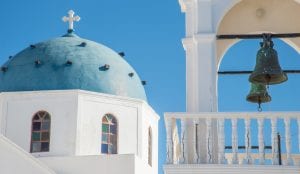Greek Orthodox Funeral Service Rituals

Greek Orthodox as it is described below refers to the affiliation of churches that come under the auspices of the Greek Orthodox Archdiocese of America.
According to the Archdiocese, there are some 540 parishes located throughout the country. That means that funeral practices may vary somewhat from family to family and by congregation and region of the country. The following describes the religion’s general funeral practices.
The Greek Orthodox Church believes death separates the soul from the body and is the beginning of a new life. The experience takes on the quality of the behavior, character, and communion with God. Later, with Christ’s coming, the final judgment will result, and each soul will spend eternity in Heaven or Hell.
Traditional Greek Orthodox funerals include five parts:
- A Wake:
It is customary for members of the Greek Orthodox church to hold a wake the night before the funeral. Loved ones and friends may be invited to speak about the deceased, and a priest may preside over the Trisagion (Thrice-Holy) service. - Funeral Service:
The funeral service, to take place at a funeral home or Greek Orthodox Church, will include hymns, prayers, and readings from the bible. The priest may also offer a sermon and speak about the deceased. The casket will likely be open, with a viewing of the deceased optional. According to tradition, the casket will face east with feet toward the altar. At the funeral service, guests can greet the family with the phrase “Memory Eternal” or offer condolences. Believers may kiss an icon or a cross that lies on the breast of the deceased, but non-believers are not required to do so. Then, the priest leads the service and reads from selected texts. Non-believers are expected to stand with the congregation and participate. At the graveside, each guest places a flower on the casket.
- Burial:
A brief graveside service is customarily held, with the Trisagion Service performed again. Hymns may also be sung, followed by a blessing by the priest. Traditionally, cremation was not permitted in the Greek Orthodox Church. It is still the position of the Greek Orthodox Archdiocese of America that cremation is not permitted. If you intend to have a Greek Orthodox funeral and would like to be cremated, we recommend that you consult with your priest or bishop. - Funeral Luncheon:
A funeral luncheon follows many Orthodox funerals, referred to as a makaria (mercy meal). Fish, an ancient Christian symbol, is typically served. Lunch is not required. - Memorial Service:
In many cases, a memorial service will be held the Sunday following the funeral. The family is also welcome to hold the Trisagion Service at certain milestones or when desired.
For information on the specific liturgy used during a Greek Orthodox funeral, we suggest you visit the Archdiocese website.
Funeral practices vary between congregations. Ceremonies may also reflect customs and traditions specific to a geographic location or community. To verify the practices of a particular congregation, consult with a clergy member.
| Greek Orthodox Quick Reference Guide | |
|---|---|
| Length of Service | 30 – 60 minutes |
| Flowers? | Yes (See our Sympathy Flowers) |
| Food? | No |
| Dress Code? (Men/Women) | Dark & Somber / Men: Jacket & Tie |
| Recording Devices? | No |
| Source of Readings? | The Divine Liturgy |
| Open Casket? | Usually |
| Return to Work? (Days) | 7 |
| No. of Days to Mourn? | Depends |
| Embalming? | Permitted |
| Cremation? | Cremation is prohibited |
| Body/Organ Donation? | Permitted |
References:
- Saint George Greek Orthodox Cathedral-Greenville, SC (http://stgeorgegreenville.org/our-faith/catechism/way-of-life/judgement)
- Greek Orthodox Archdiocese of America (https://www.goarch.org)

